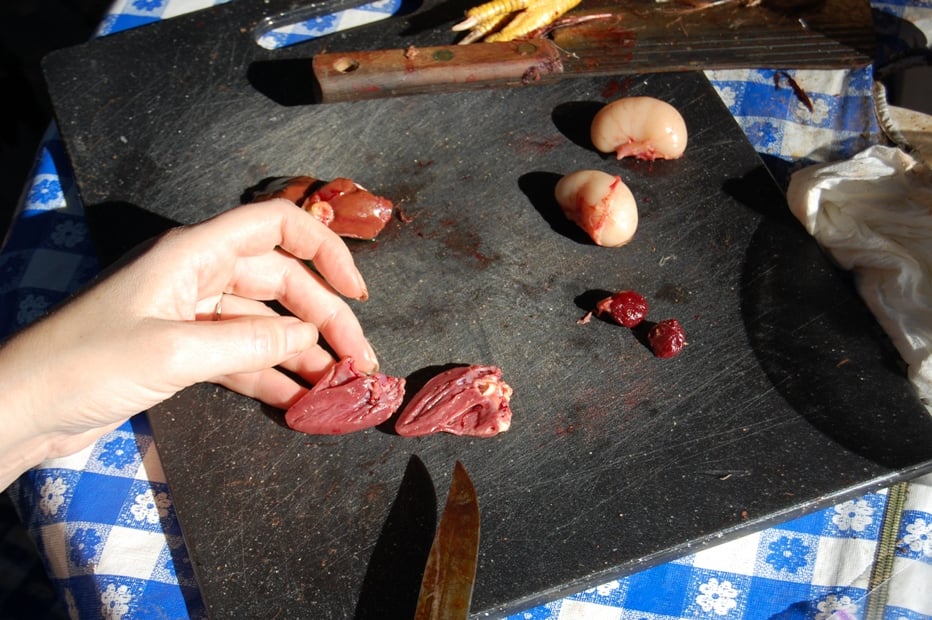Castlemaid
Songster
So after keeping chickens for about two years, I screwed up my courage to dispatch and process my first bird: A young rooster, not quite a year old, too big for his britches. I've never killed, gutted and cleaned anything before, but with the help of Youtube videos, I think I managed it very well. (Kind of proud of myself!). I have a couple of questions though that I have not yet found any internet answer for.
One, I killed the rooster by holding his head down with a broomstick I was standing on, and pulled up on the bird to break its neck (Separate the head from the neck). This method is in one of my chicken books. I then hung him up, and slit its throat, but the blood coming out was already all coagulated? Is this normal? It was like jelly-like chunks. It's a few degrees below freezing here, would that have anything to do with it? The rooster is a small bird, not a bantam, but from a breed that stays smaller.
Second, the plucking went really easy. I was dreading that part, thinking it was going to be a pain and a huge mess, but with a hot water dip, it was no issue at all.
And third, the biggest mystery of all: His kidneys were pure white. The bird had been healthy and my oldest Rooster at about 10 months old (I have a couple of younger ones). So king of his coop and yard, no sign of disease at all. He's been eating 16% chicken layer pellets, and some scratch, and whatever they can find roaming on the frozen, snow-covered property. I have 3 adult hens, and five up-coming pullets/cockerels about four months old, all eating the same thing. Though I'm no expert, all his organs looked normal and healthy, the liver being a gorgeous dark maroon. The Kidneys seemed a bit bloated, a bit bigger than what I see in store-bought chickens. Bright red blood vessels were contrasting to the white kidneys.
I did an internet search and found one other post on here from several years ago where a person had the same thing with her roosters, but nobody had seen that before. It didn't have the signs of gout with the uric acid deposits on the internal organs.
Thanks for reading through this, I appreciate your help.
One, I killed the rooster by holding his head down with a broomstick I was standing on, and pulled up on the bird to break its neck (Separate the head from the neck). This method is in one of my chicken books. I then hung him up, and slit its throat, but the blood coming out was already all coagulated? Is this normal? It was like jelly-like chunks. It's a few degrees below freezing here, would that have anything to do with it? The rooster is a small bird, not a bantam, but from a breed that stays smaller.
Second, the plucking went really easy. I was dreading that part, thinking it was going to be a pain and a huge mess, but with a hot water dip, it was no issue at all.
And third, the biggest mystery of all: His kidneys were pure white. The bird had been healthy and my oldest Rooster at about 10 months old (I have a couple of younger ones). So king of his coop and yard, no sign of disease at all. He's been eating 16% chicken layer pellets, and some scratch, and whatever they can find roaming on the frozen, snow-covered property. I have 3 adult hens, and five up-coming pullets/cockerels about four months old, all eating the same thing. Though I'm no expert, all his organs looked normal and healthy, the liver being a gorgeous dark maroon. The Kidneys seemed a bit bloated, a bit bigger than what I see in store-bought chickens. Bright red blood vessels were contrasting to the white kidneys.
I did an internet search and found one other post on here from several years ago where a person had the same thing with her roosters, but nobody had seen that before. It didn't have the signs of gout with the uric acid deposits on the internal organs.
Thanks for reading through this, I appreciate your help.





